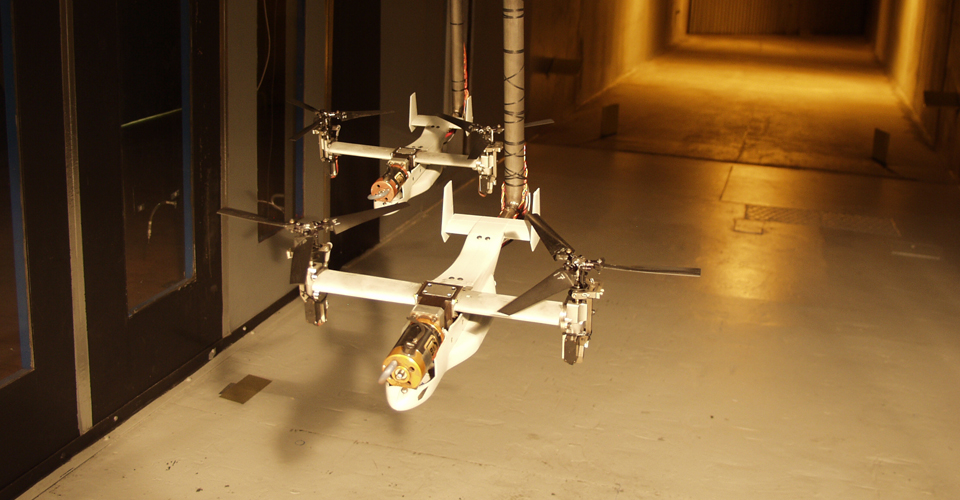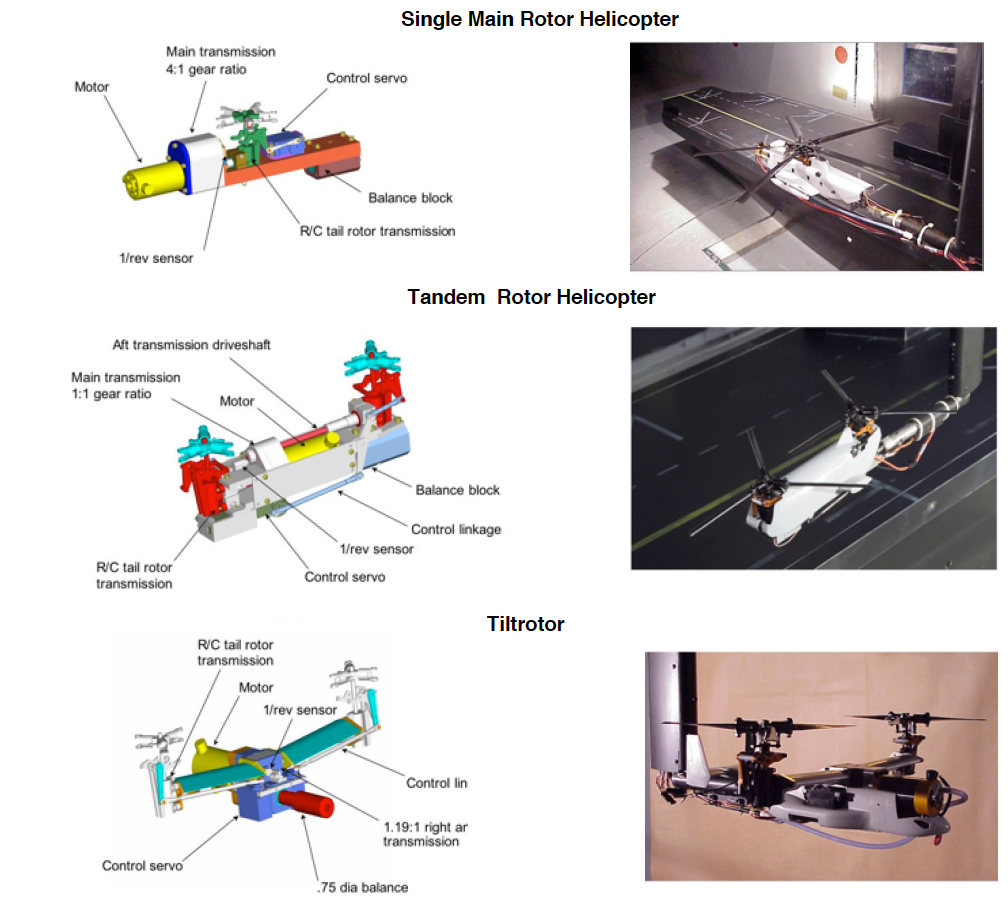Interactional Aerodynamics Assessment
Using Radio-Controlled Models

The Aeromechanics Branch of the Flight Vehicle Research and Technology Division has designed and fabricated a suite of radio-controlled aircraft to investigate aerodynamic interaction phenomena between multiple aircraft information flight, in ground effect, and in the vicinity of large structures such as buildings or ships. The 1/48th-scale aircraft models are mounted on precision balances and have been tested in the 7- by 10-foot wind tunnel. By matching non-dimensional full-scale aircraft thrust coefficient and advance ratio, wake interactions representative of full-scale events have been successfully captured. The models are primarily made of off-the-shelf components, are extremely robust, and easy to operate. Data acquired from these models have provided guidance to the Navy in planning full-scale flight tests. Topics such as aircraft spacing to avoid wake hazard issues, rotor outwash effects on ground personnel, and operations aboard ships have been successfully simulated.
Background
Leveraging funding provided by the U.S. Army and the U.S. Navy, the Aeromechanics Branch has developed an extremely cost-effective means of quantifying aerodynamic interaction effects between multiple aircraft in formation flight, in ground effect, and in the vicinity of large structures. Three types of rotorcraft have been designed and fabricated to date: single main rotor helicopter, tandem-rotor helicopter, and tiltrotor. A precision 6-component force and moment balance has been integrated into the design of each 1/48thscale radio-controlled (RC) aircraft. The controller and many of the aircraft parts are off-the-shelf components. Several experiments have been conducted in the Army 7- by 10-Foot Wind Tunnel at NASA Ames using these RC models. The experimental results are providing valuable guidance in determining the effect of upwind aircraft location on a downwind on-deck aircraft, characterizing the airwake of a ship, characterizing the combined ship/rotorcraft airwake, and determining safe formation flight configurations for tiltrotors in- and out-of-ground effect for terminal area operations (Refs. 1-5). In addition, the database is a valuable source for validating analyses (Refs. 6-7). The careful test techniques developed by the Aeromechanics Branch for these models combined with Branch expertise in flow measurement techniques (such as Particle Image Velocimetry) have resulted in a unique capability at Ames Research Center. There are many possibilities for designing and testing other vehicle types.
Overview of Aircraft Models
Reference 4 describes the model designs in detail. Four aircraft models were fabricated, representing 3 types of The Aeromechanics Branch of the Flight Vehicle Research and Technology Division has designed and fabricated a suite of radio-controlled aircraft to investigate aerodynamic interaction phenomena between multiple aircraft in formation flight, in ground effect, and in the vicinity of large structures such as buildings or ships. The 1/48th-scale aircraft models are mounted on precision balances and have been tested in the 7- by 10-foot wind tunnel. By matching non-dimensional full-scale aircraft thrust coefficient and advance ratio, wake interactions representative of full-scale events have been successfully captured. The models are primarily made of off-the-shelf components, are extremely robust, and easy to operate. Data acquired from these models have provided guidance to the Navy in planning full-scale flight tests. Topics such as aircraft spacing to avoid wake hazard issues, rotor outwash effects on ground personnel, and operations aboard ships have been successfully simulated. aircraft: tiltrotor, tandem rotor helicopter and single main rotor helicopter. Full-scale V-22, CH-46, and CH-53E dimensions guided the designs. The primary modeling parameters were rotor diameter, solidity, rotor-rotor position and rotor tip speed. Additionally, for the tiltrotor, the rotor-wing separation was modeled accurately. All of the models used rigid hubs and had collective control only (no cyclic). The hub and control systems were commercially available radio-control (RC) model helicopter tail-rotor assemblies. The rotor blade pitch cases were redesigned to minimize the blade root cutout. The models were mounted on 0.75-inch diameter, six component balances. High-power-density RC model motors were selected with physical dimensions compatible with the scale of the models. Each aircraft used a single AstroCobalt-40 sport motor (AstroFlight, Inc, Model #640) mounted within the aircraft to power the rotor(s). Gear ratios for each transmission were chosen to provide near optimum motor operation at the selected rotor rpm. Rotor rpm was selected based on the available power, with some design margin (25%) on the estimated power requirement. The available motor power limited the maximum tip speed of the models to approximately 33% of full-scale.
Commercially available R/C radio transmitters, receivers, speed controllers, governors and control servos were used to remotely control rotor rpm and collective pitch. Two identical DC power supplies rated for 30 Amps at 25 Volts, powered the model motors. Batteries were used to power the collective control servo motors and speed controller.

Benefits
The RC models have proven to be a cost-effective and low risk means of investigating full-scale interactional aerodynamics phenomena. The data acquired using the RC models is consistent with full-scale events and provides information beyond the limited, and much more expensive, full-scale testing envelopes. The methodology for designing, fabricating, and testing the models can be applied to other vehicle configurations. The unique interdisciplinary technology experts within the Aeromechanics Branch can enable a wide-variety of vehicle concepts to be developed.
References
If needed: Download Acrobat Reader
Silva, M. J., Yamauchi, G. K., Wadcock, A. J. and Long, K. R., “Wind Tunnel Investigation of the Aerodynamic Interactions Between Helicopters and Tilt-rotors in a Shipboard Environment,” American Helicopter Society 4th Decennial Specialist's Conference on Aeromechanics, San Francisco, CA, January 2004. Download
Wadcock, A. J., Yamauchi, G. K., Heineck, J. T., Silva, M. J., and Long, K. R., “PIV Measurements of the Wake of a Tandem-Rotor Helicopter in Proximity to a Ship,” American Helicopter Society 4th Decennial Specialist's Conference on Aeromechanics, San Francisco, CA, January 2004. Download
Yamauchi, G. K., Wadcock, A. J., and Derby, M. D., “Measured Aerodynamic Interaction Between Two Tiltrotors,” American Helicopter Society 59th Annual Forum, Phoenix, AZ, May 2003. Download
Derby, M. R. and Yamauchi, G. K., “Design of 1/48th- Scale Models for Ship-Rotorcraft Interaction Studies,” 21st AIAA Applied Aerodynamics Conference, AIAA-2005-1347, Orlando, FL, June 2003. Download
Silva, M. J., Wadcock, A. J, Yamauchi, G. K., Van Aken, J. M., and Shinoda, P. M., “ Wind Tunnel Investigation of the Shipboard Aerodynamic Interactions Inducing the V-22 Tiltrotor Uncommanded Roll on-Deck Response,” American Helicopter Society 61st Annual Forum, Grapevine, TX, June 2005. Download
Johnson, W., Derby, M. D., Wadcock, A. J., and Yamauchi, G. K., “Wind Tunnel Measurements and Calculations of Aerodynamic Interactions Between Tiltrotor Aircraft,” American Institute of Aeronautics and Astronautics, 41st Aerospace Sciences Meeting and Exhibit, Reno, NV, January 2003. Download
Rajagopalan, R. G., Niazi, S., Wadcock, A. J., Yamauchi, G. K., and Silva, M. J., “Experimental and Computational Study of the Interaction Between a Tandem-Rotor Helicopter and a Ship,” American Helicopter Society 61st Annual Forum, Grapevine, TX, June 2005. Download
Point of Contact
Gloria Yamauchi
NASA Ames Research Center
Moffett Field CA 94035-1000